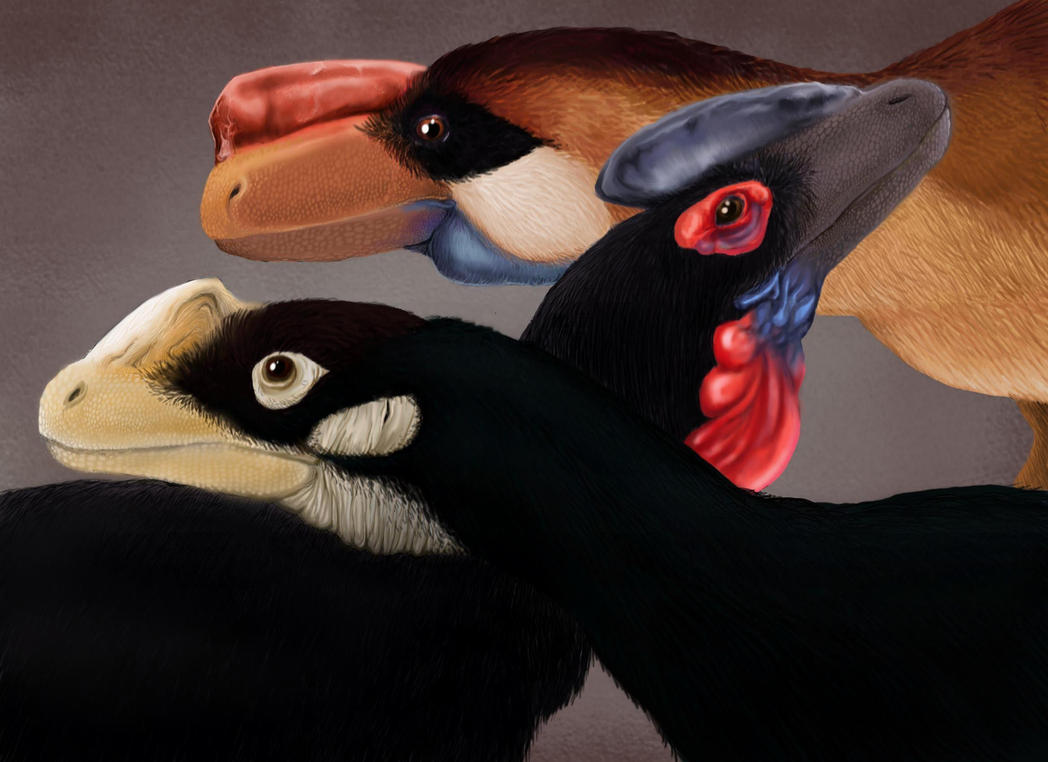Post by creature386 on Feb 13, 2013 0:33:58 GMT 5
Saltriovenator zallenai

Temporal range: Early Jurassic
Descripton: Saltriosaurus was a Genus of theropods, mentioned by Dal Sasso (but not described), in 2000 and discovered in the Sinemurian (lower jurassic, ~190 million years ago) Saltrio Formation, near Saltrio, Varese, Italy, in 1996 [1]. In english the name means"lizard from Saltrio". Here are some of the fossils:

We found a Holotype called "MSNM V3664", including lateral tooth, dorsal rib fragments, scapular fragment, furcula, humeri, metacarpal II, phalanx II-1, phalanx III-1, phalanx III-2, manual ungual III, proximal fibula, distal tarsal III, distal tarsal IV(all in all it were more than 100)[2] . The skeleton we found is 10% complete. It's estimated to be 8 meters long and to weigh 0,5-1,5t[2][3][4] . It walked bipedal(on two legs)and it had a pretty long neck. The skeleton was reconstructes after these bones and it looked on the reconstruction a bit like Allosaurus. The skeleton is 26 feet long, 13 feet tall and has a 70 cm long skull, with 7 cm teeth. Too scientists suggest that north-Italia and Switzerland were connected in the early jurassic, because such a big animal would need wide hunting ranges to survive. Quoting Dal Sasso:
[4] . Too this dino is important in the history of theropods, because it shows that advanced theropods came earlier than tought.
Classification: The classification is a hard task, due to the very decent knowledge about this dinosaur, due to it's rather fragmentary fossils (see above). It is a nomen nudum that means it can't be matched to a group quite well.
It could have been a coelurosaur rather than a tetanuran dinosaur, because the presence of a furucla alone doesn't support it to be a tetanuran, because many coelophysids aswell had it[1]. So we have to await more detailed studies regarding this dinosaur.
Here another image:

Footnotes:
[1] M. T. Carrano, R. B. J. Benson, S. D. Sampson: The phylogeny of Tetanurae (Dinosauria: Theropoda). In: Journal of Systematic Palaeontology. 10, Nr. 2, 2012, S. 233 link
[2] archosaur.us/theropoddatabase/Tetanurae.htm#Saltriosaurus
[3] books.google.de/books/about/Saltriosaurus.html?id=tIOxuAAACAAJ&redir_esc=y
[4] digilander.libero.it/tulse/6ewvp/abstractbook%206ewvp.pdf

Temporal range: Early Jurassic
Descripton: Saltriosaurus was a Genus of theropods, mentioned by Dal Sasso (but not described), in 2000 and discovered in the Sinemurian (lower jurassic, ~190 million years ago) Saltrio Formation, near Saltrio, Varese, Italy, in 1996 [1]. In english the name means"lizard from Saltrio". Here are some of the fossils:

We found a Holotype called "MSNM V3664", including lateral tooth, dorsal rib fragments, scapular fragment, furcula, humeri, metacarpal II, phalanx II-1, phalanx III-1, phalanx III-2, manual ungual III, proximal fibula, distal tarsal III, distal tarsal IV(all in all it were more than 100)[2] . The skeleton we found is 10% complete. It's estimated to be 8 meters long and to weigh 0,5-1,5t[2][3][4] . It walked bipedal(on two legs)and it had a pretty long neck. The skeleton was reconstructes after these bones and it looked on the reconstruction a bit like Allosaurus. The skeleton is 26 feet long, 13 feet tall and has a 70 cm long skull, with 7 cm teeth. Too scientists suggest that north-Italia and Switzerland were connected in the early jurassic, because such a big animal would need wide hunting ranges to survive. Quoting Dal Sasso:
Unlike previous geological studies,
these findings are a compelling evidence that during Mesozoic times the Italian peninsula was not
completely submerged by the Tethys Ocean. The model of small islands within a carbonatic platform
is also insufficient to explain the presence of large land animals such as the eight-meter-long
'Saltriosaur', given that predatory dinosaurs occupied the apex of a complex, definitely terrestrial
alimentary pyramid. It is more likely that continental bridges temporarily connected Laurasia and
Gondwana in the central Tethys, allowing not only migrations between the two hemispheres, but also
genetic drift during marine transgressions.
these findings are a compelling evidence that during Mesozoic times the Italian peninsula was not
completely submerged by the Tethys Ocean. The model of small islands within a carbonatic platform
is also insufficient to explain the presence of large land animals such as the eight-meter-long
'Saltriosaur', given that predatory dinosaurs occupied the apex of a complex, definitely terrestrial
alimentary pyramid. It is more likely that continental bridges temporarily connected Laurasia and
Gondwana in the central Tethys, allowing not only migrations between the two hemispheres, but also
genetic drift during marine transgressions.
[4] . Too this dino is important in the history of theropods, because it shows that advanced theropods came earlier than tought.
Classification: The classification is a hard task, due to the very decent knowledge about this dinosaur, due to it's rather fragmentary fossils (see above). It is a nomen nudum that means it can't be matched to a group quite well.
It could have been a coelurosaur rather than a tetanuran dinosaur, because the presence of a furucla alone doesn't support it to be a tetanuran, because many coelophysids aswell had it[1]. So we have to await more detailed studies regarding this dinosaur.
Here another image:
Footnotes:
[1] M. T. Carrano, R. B. J. Benson, S. D. Sampson: The phylogeny of Tetanurae (Dinosauria: Theropoda). In: Journal of Systematic Palaeontology. 10, Nr. 2, 2012, S. 233 link
[2] archosaur.us/theropoddatabase/Tetanurae.htm#Saltriosaurus
[3] books.google.de/books/about/Saltriosaurus.html?id=tIOxuAAACAAJ&redir_esc=y
[4] digilander.libero.it/tulse/6ewvp/abstractbook%206ewvp.pdf








